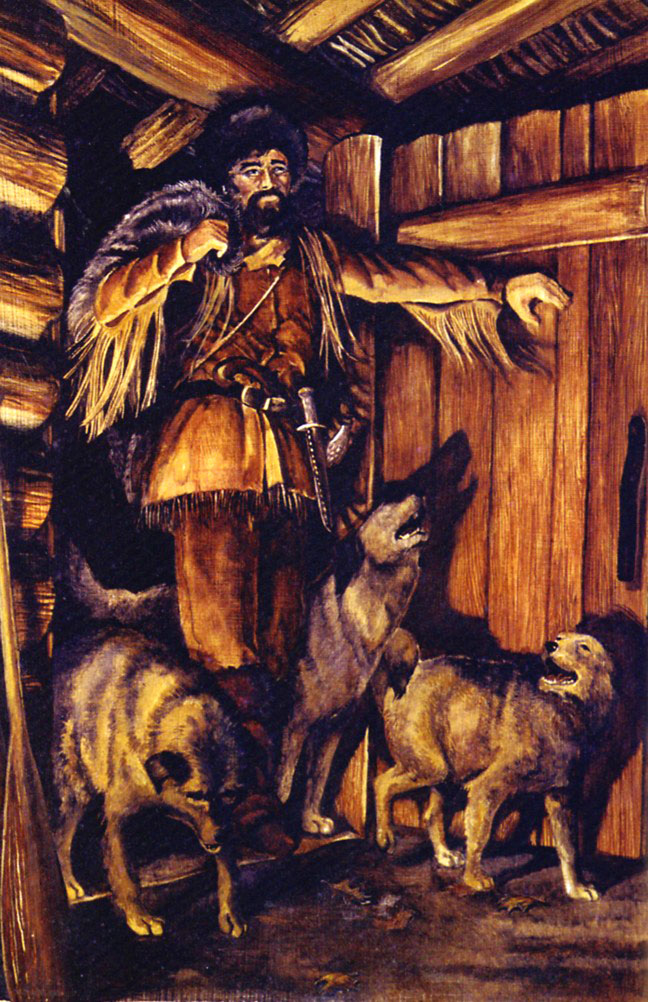Peter Pond newsletter :: OCTOBER 2000 :: #4
PETER POND WEBSITE GETS GOOD MARKS
Things have happened since we last corresponded. Lightning zapped my computer on September 19th, and I have only recently recovered, mainly buying a new and better one. The files on the old hard drive are still OK, according to a friend who tinkered with it, and when he gets around to it, he'll put it in my new computer. In the meantime, I hope I still have all Peter Pond Society members' emails included in this message.
The website has received more than 1500 hits. Seems school kids have found it, and two have thanked me for helping give them good marks in their history classes. I think I'm on some kind of homework resource site called schoolzone.net, but have haven't been able to find myself there.
FUR TRADE BOOK
I am re-reading a wonderful novel about the fur trade era, The Grand Portage, by Walter O'Meara (Bobbs-Merrill, 1951). It is a fleshing out of a rather dry diary kept by Daniel Harmon of Vergennes, VT as he spent 20 years in the Canadian fur trade in the early 1800s as a North West Company clerk.
In the beginning, he vows never to succumb to the wiles of Indian maidens as so many other Norwesters did, but in the end finally marries one and lives happily ever after. I know of few other novels of the period. Can anyone name more?
PLANNED PETER POND PILGRIMAGE
I am about to embark on another sort of Peter Pond Pilgrimage, this time visiting Montreal where the NWC was based and Pond got to know well. I will be staying in the Queen Elizabeth Hotel the weekend of October 28-29, taking part in a barbershop chorus-singing contest. I'll check out the Beaver Club restaurant, but hear it is on the expensive side.
What do I want to see in a weekend in Montreal when most of the time will have to be devoted to the contest? I have decided it should be: Simon McTavish's burial place, the Lachine dock where the voyageurs' canoes left for the interior, and the site of the St. Anne church at the western tip of Montreal island where they blessed themselves for a safe journey just after leaving Lachine.
After corresponding with a guide named Daniel at the Fur Trade National Historic Site at Lachine, I have some interesting information. He directed me to the Montreal marker for McTavish, the founder and chairman of NWC who, when he died in 1804, left NWC more powerful than Hudson's Bay Co. If the two concerns had merged then, as almost happened, it probably would have been NWC that swallowed HBC instead of the other way around (as happened 20 years later).
McTavish was buried at the foot of Mount Royal in the garden of his half-finished mansion, leaving a young wife and four children. The city never protected the spot, so the family about 40 years later transferred the remains to another place that remains a secret. Today, a small monument marks the original resting place, even though he is not there. I am told to climb stairs going up into Mt. Royal Park from the northern end of Peel Street where it crosses Avenue des Pins, and I'll find the monument.
Then I'll head for the Lachine embarkation spot, which is also the Fur Trade National Historic Site that includes a museum. I'm not sure how much time I'll have to browse the museum, since I'm trying to catch these three spots within three hours. I'd go either Friday afternoon sometime after 2PM when our bus is supposed to arrive at the Queen Elizabeth, or Sunday from 9AM before the bus heads home at 1PM. I figure I'd be better off going Sunday morning when there would be less traffic, since I plan to hire a cab that would be going by the meter. Maybe we can haggle a flat fee. It will mainly be nice to see the spot where the canoes left, just at the top of the Lachine rapids, at the bottom of which the ocean-going ships waited to transport the furs to London market.
So, if I hire the cab Sunday, despite a likely late Saturday night of partying, Friday should be devoted to catching the world-famous McCord Museum and its three Beaver Club medals, about three blocks from the QE.
After Lachine, I'll go to the St. Anne church or chapel at the island's western tip, where the voyageurs stopped to bless themselves, the practice of which is described in Pond's diary. On my map of Montreal, I measure 15 miles from the western tip to the Lachine dock, and the dock about eight miles from the McTavish monument in the city's downtown, some six blocks from QE. The thing is, Daniel says, the church no longer exists. But I should look for a retirement home at 171 Sainte-Anne Street in the town of St. Anne-de-Bellevue at the island's western tip, because that is where the church was. The retirement home was originally a convent, so the building is known as le vieux couvent or the old convent, located next to the lockmaster's house, so it can't be far from water. A church in various forms was there from 1705, transformed to a school in 1890, a convent from 1900, and has been a retirement home since the 1960s. For some reason, no plaque marks the current building as the voyageurs' last stopping place in civilization before heading to the wild north.
So that's my plan. It may not be the path of the typical tourist, but it should interest a fur trade student like me. Pond knew McTavish well and passed through those two other spots. My next newsletter will be about what I found and/or how I did. Wish me luck.

Au revoir,
Bill
website design by Daniel Ortoleva
